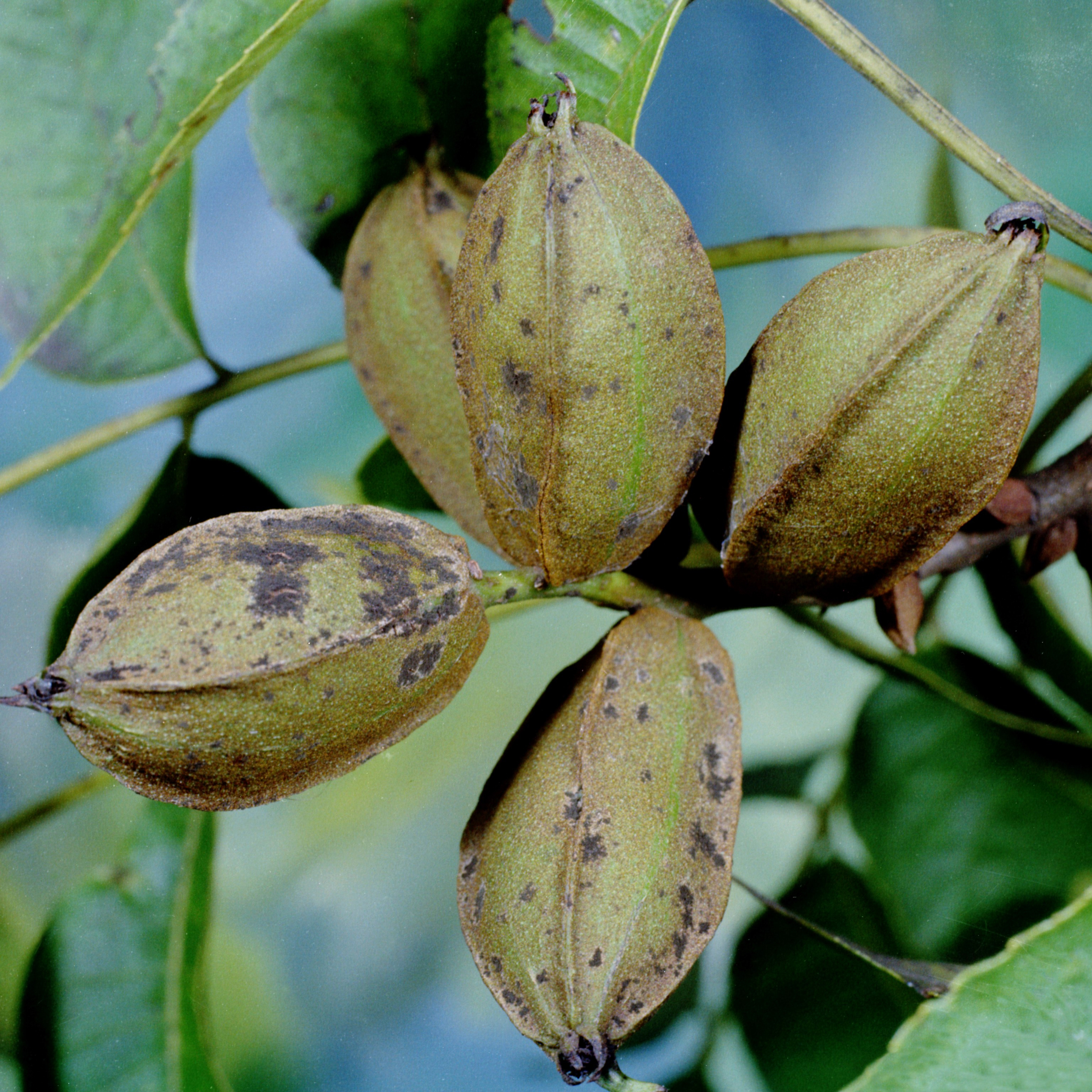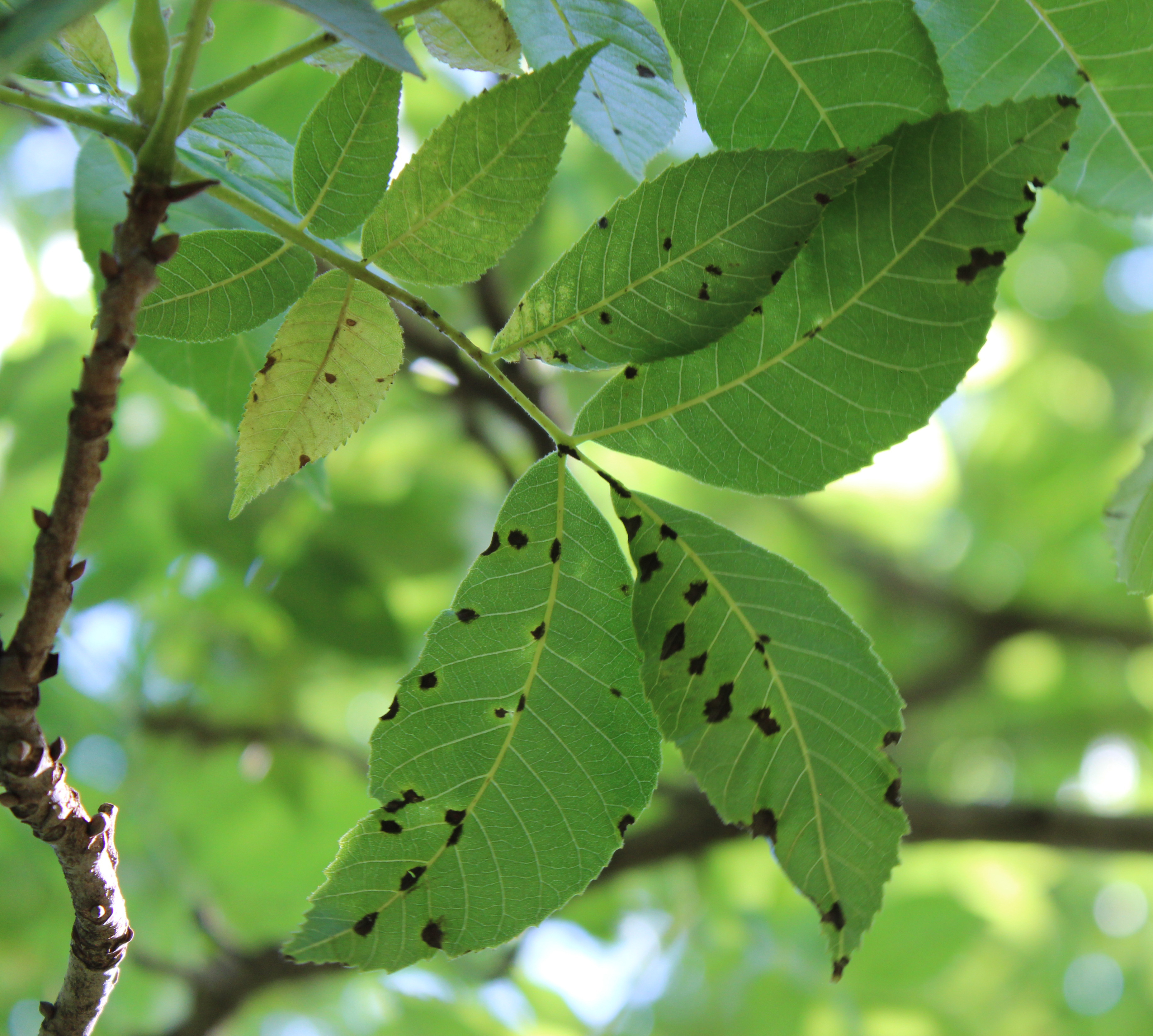|
Pecan Scab
Pecan scab is the most economically significant disease of pecan trees (''Carya illinoinensis'') in the southeastern United States.Sanderlin, R. S. (n.d.). Pecan scab disease. Retrieved from http://www.lsuagcenter.com/NR/rdonlyres/A30CB512-CDB1-4DFB-8D41-9E6086DEF9EE/70679/ScabDisease_CorrectedName.pdf ''Venturia effusa'' is a fungal plant pathogen that causes pecan scab. The fungus causes lesions and tissue death on pecan twigs, petioles, leaves, nuts and shucks beginning in early spring, with multiple cycles of infection repeating until late summer. Wind and rain spread the fungus to a susceptible host. Control of the disease is achieved by fungicide, sanitation and, in some cases, quarantine.Smith, S., & Vann, S. (2013). Arkansas plant disease control products guide. Informally published manuscript, Division of Agriculture, University of Arkansas, Little Rock, AR, Retrieved from http://www.uaex.edu/Other_Areas/publications/PDF/MP154/pecan-diseases-commercial.pdf Since its first ... [...More Info...] [...Related Items...] OR: [Wikipedia] [Google] [Baidu] |
Pecan
The pecan (''Carya illinoinensis'') is a species of hickory native to the southern United States and northern Mexico in the region of the Mississippi River. The tree is cultivated for its seed in the southern United States, primarily in Georgia, New Mexico, Texas, and Mexico, which produces nearly half of the world total. The seed is an edible nut used as a snack and in various recipes, such as praline candy and pecan pie. The pecan is the state nut of Alabama, Arkansas, California, and Texas and is also the state tree of Texas. Name "Pecan" is from an Algonquin word, variously referring to pecans, walnuts, and hickory nuts. There are many pronunciations, some regional and others not.See "Pecan" at Wiktionary. The most common American pronunciation is . There is little agreement in the United States regarding the "correct" pronunciation, even regionally. Growth The pecan tree is a large deciduous tree, growing to in height, rarely to .Flora of North America''Carya illinoi ... [...More Info...] [...Related Items...] OR: [Wikipedia] [Google] [Baidu] |
Venturia Effusa
''Venturia effusa'' is a sexual species in the fungal genus '' Venturia''. ''Venturia effusa'' was first described in 1885. ''Venturia effusa'' is a fungal pathogen of pecan trees (''Carya illinoinensis''), on which it causes pecan scab. The fungus is highly pathogenic and causes substantial economic losses throughout the southeastern United States. Genome The complete genome In the fields of molecular biology and genetics, a genome is all the genetic information of an organism. It consists of nucleotide sequences of DNA (or RNA in RNA viruses). The nuclear genome includes protein-coding genes and non-coding ge ... sequence of ''Venturia effusa'', the first complete genome sequence of any species in the genus '' Venturia'', was reported in 2019. The 45 Mb genome comprises 20 chromosomes, ranging from 0.56 to 4.1 Mb, including approximately 10,800 genes. References {{Taxonbar, from=Q79274067 Venturiaceae ... [...More Info...] [...Related Items...] OR: [Wikipedia] [Google] [Baidu] |
Fungus
A fungus ( : fungi or funguses) is any member of the group of eukaryotic organisms that includes microorganisms such as yeasts and molds, as well as the more familiar mushrooms. These organisms are classified as a kingdom, separately from the other eukaryotic kingdoms, which by one traditional classification include Plantae, Animalia, Protozoa, and Chromista. A characteristic that places fungi in a different kingdom from plants, bacteria, and some protists is chitin in their cell walls. Fungi, like animals, are heterotrophs; they acquire their food by absorbing dissolved molecules, typically by secreting digestive enzymes into their environment. Fungi do not photosynthesize. Growth is their means of mobility, except for spores (a few of which are flagellated), which may travel through the air or water. Fungi are the principal decomposers in ecological systems. These and other differences place fungi in a single group of related organisms, named the ''Eumycota'' (''true f ... [...More Info...] [...Related Items...] OR: [Wikipedia] [Google] [Baidu] |
Plant Pathogen
Plant pathology (also phytopathology) is the scientific study of diseases in plants caused by pathogens (infectious organisms) and environmental conditions (physiological factors). Organisms that cause infectious disease include fungi, oomycetes, bacteria, viruses, viroids, virus-like organisms, phytoplasmas, protozoa, nematodes and parasitic plants. Not included are ectoparasites like insects, mites, vertebrate, or other pests that affect plant health by eating plant tissues. Plant pathology also involves the study of pathogen identification, disease etiology, disease cycles, economic impact, plant disease epidemiology, plant disease resistance, how plant diseases affect humans and animals, pathosystem genetics, and management of plant diseases. Overview Control of plant diseases is crucial to the reliable production of food, and it provides significant problems in agricultural use of land, water, fuel and other inputs. Plants in both natural and cultivated populat ... [...More Info...] [...Related Items...] OR: [Wikipedia] [Google] [Baidu] |
Pecan Scab
Pecan scab is the most economically significant disease of pecan trees (''Carya illinoinensis'') in the southeastern United States.Sanderlin, R. S. (n.d.). Pecan scab disease. Retrieved from http://www.lsuagcenter.com/NR/rdonlyres/A30CB512-CDB1-4DFB-8D41-9E6086DEF9EE/70679/ScabDisease_CorrectedName.pdf ''Venturia effusa'' is a fungal plant pathogen that causes pecan scab. The fungus causes lesions and tissue death on pecan twigs, petioles, leaves, nuts and shucks beginning in early spring, with multiple cycles of infection repeating until late summer. Wind and rain spread the fungus to a susceptible host. Control of the disease is achieved by fungicide, sanitation and, in some cases, quarantine.Smith, S., & Vann, S. (2013). Arkansas plant disease control products guide. Informally published manuscript, Division of Agriculture, University of Arkansas, Little Rock, AR, Retrieved from http://www.uaex.edu/Other_Areas/publications/PDF/MP154/pecan-diseases-commercial.pdf Since its first ... [...More Info...] [...Related Items...] OR: [Wikipedia] [Google] [Baidu] |
Juglans
Walnut trees are any species of tree in the plant genus ''Juglans'', the type genus of the family Juglandaceae, the seeds of which are referred to as walnuts. All species are deciduous trees, tall, with pinnate leaves , with 5–25 leaflets; the shoots have chambered pith, a character shared with the wingnuts (''Pterocarya''), but not the hickories (''Carya'') in the same family. The 21 species in the genus range across the north temperate Old World from southeast Europe east to Japan, and more widely in the New World from southeast Canada west to California and south to Argentina. Edible walnuts, which are consumed worldwide, are usually harvested from cultivated varieties of the species ''Juglans regia''. China produces half of the world total of walnuts. Etymology The common name ''walnut'' derives from Old English ''wealhhnutu'', literally 'foreign nut' (from ''wealh'' 'foreign' + ''hnutu'' 'nut'), because it was introduced from Gaul and Italy. The Latin name for the wal ... [...More Info...] [...Related Items...] OR: [Wikipedia] [Google] [Baidu] |
Conidium
A conidium ( ; ), sometimes termed an asexual chlamydospore or chlamydoconidium (), is an asexual, non-motile spore of a fungus. The word ''conidium'' comes from the Ancient Greek word for dust, ('). They are also called mitospores due to the way they are generated through the cellular process of mitosis. The two new haploid cells are genetically identical to the haploid parent, and can develop into new organisms if conditions are favorable, and serve in biological dispersal. Asexual reproduction in ascomycetes (the phylum Ascomycota) is by the formation of conidia, which are borne on specialized stalks called conidiophores. The morphology of these specialized conidiophores is often distinctive between species and, before the development of molecular techniques at the end of the 20th century, was widely used for identification of (''e.g.'' ''Metarhizium'') species. The terms microconidia and macroconidia are sometimes used. Conidiogenesis There are two main types of co ... [...More Info...] [...Related Items...] OR: [Wikipedia] [Google] [Baidu] |
Teleomorph, Anamorph And Holomorph
In mycology, the terms teleomorph, anamorph, and holomorph apply to portions of the life cycles of fungi in the phyla Ascomycota and Basidiomycota: *Teleomorph: the sexual reproductive stage (morph), typically a fruiting body. *Anamorph: an asexual reproductive stage (morph), often mold-like. When a single fungus produces multiple morphologically distinct anamorphs, these are called synanamorphs. *Holomorph: the whole fungus, including anamorphs and teleomorph. Dual naming of fungi Fungi are classified primarily based on the structures associated with sexual reproduction, which tend to be evolutionarily conserved. However, many fungi reproduce only asexually, and cannot easily be classified based on sexual characteristics; some produce both asexual and sexual states. These problematic species are often members of the Ascomycota, but a few of them belong to the Basidiomycota. Even among fungi that reproduce both sexually and asexually, often only one method of reproduction can be ... [...More Info...] [...Related Items...] OR: [Wikipedia] [Google] [Baidu] |
Dothideomycetes
Dothideomycetes is the largest and most diverse class of ascomycete fungi. It comprises 11 orders 90 families, 1300 genera and over 19,000 known species. Traditionally, most of its members were included in the loculoascomycetes, which is not part of the currently accepted classification. This indicates that several traditional morphological features in the class are not unique and DNA sequence comparisons are important to define the class. The designation loculoascomycetes was first proposed for all fungi which have ascolocular development. This type of development refers to the way in which the sexual structure, bearing the sexual spores (ascospores) forms. Dothideomycetes mostly produce flask-like structures referred to as pseudothecia, although other shape variations do exist (e.g. see structures found in Hysteriales). During ascolocular development pockets (locules) form first within the vegetative cells of the fungus and then all the subsequent structures form. These includ ... [...More Info...] [...Related Items...] OR: [Wikipedia] [Google] [Baidu] |
Elliot Pecan
The Elliot Pecan, or Elliott Pecan, is a pecan variety planted predominantly in Georgia and Florida. The nut is distinguishable by its smooth shell and small, tear-drop shape. The first Elliot tree was a seedling in the lawn of the American lumberman Henry Elliot in Milton, Florida. The Elliot Pecan tree is among the most disease-resistant pecan trees planted in the Southeastern United States. History and characteristics The original Elliot tree in Henry Elliot's lawn had a trunk diameter of and was noted for its resistance to pecan scab and other diseases. The tree annually produced up to of pecan nuts. In 1919, the Elliot family shared some of their pecans with Mr. Harlan of Harlan Farms Nursery in Paxton, Florida. Mr. Harlan was so impressed with the quality of the Elliot Pecan that he planted a orchard of trees using bud wood that the Elliot family had given him. The orchard was then sold to Otis Mathis, whom the Florida Pecan Grower's Association credit with advancing the E ... [...More Info...] [...Related Items...] OR: [Wikipedia] [Google] [Baidu] |
Fungal Tree Pathogens And Diseases
A fungus ( : fungi or funguses) is any member of the group of eukaryotic organisms that includes microorganisms such as yeasts and molds, as well as the more familiar mushrooms. These organisms are classified as a kingdom, separately from the other eukaryotic kingdoms, which by one traditional classification include Plantae, Animalia, Protozoa, and Chromista. A characteristic that places fungi in a different kingdom from plants, bacteria, and some protists is chitin in their cell walls. Fungi, like animals, are heterotrophs; they acquire their food by absorbing dissolved molecules, typically by secreting digestive enzymes into their environment. Fungi do not photosynthesize. Growth is their means of mobility, except for spores (a few of which are flagellated), which may travel through the air or water. Fungi are the principal decomposers in ecological systems. These and other differences place fungi in a single group of related organisms, named the ''Eumycota'' (''true fungi' ... [...More Info...] [...Related Items...] OR: [Wikipedia] [Google] [Baidu] |




.jpg)

